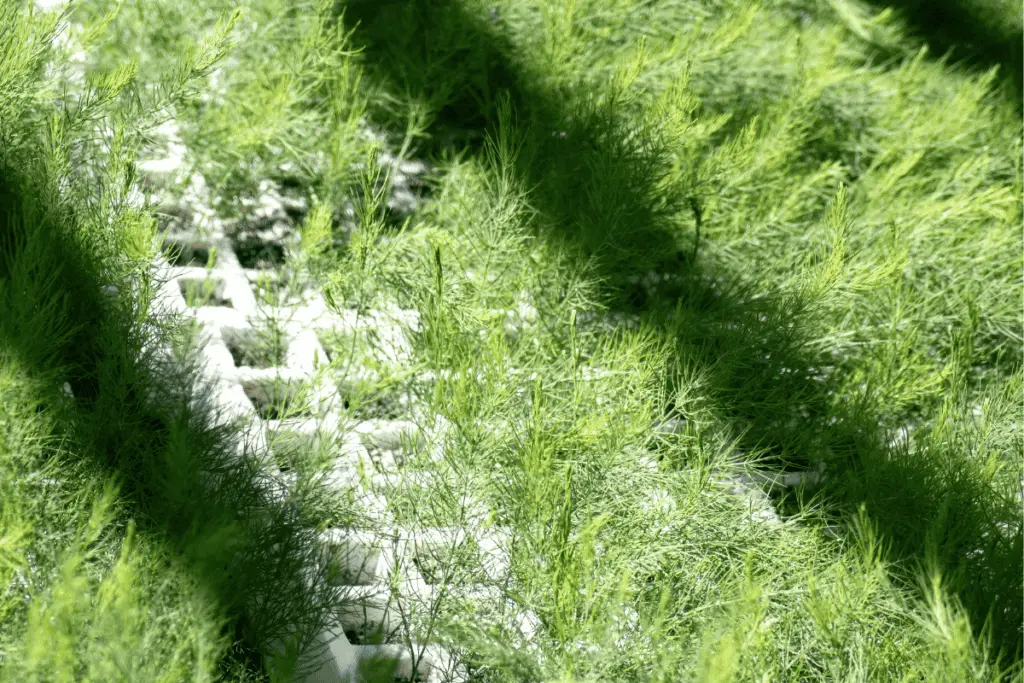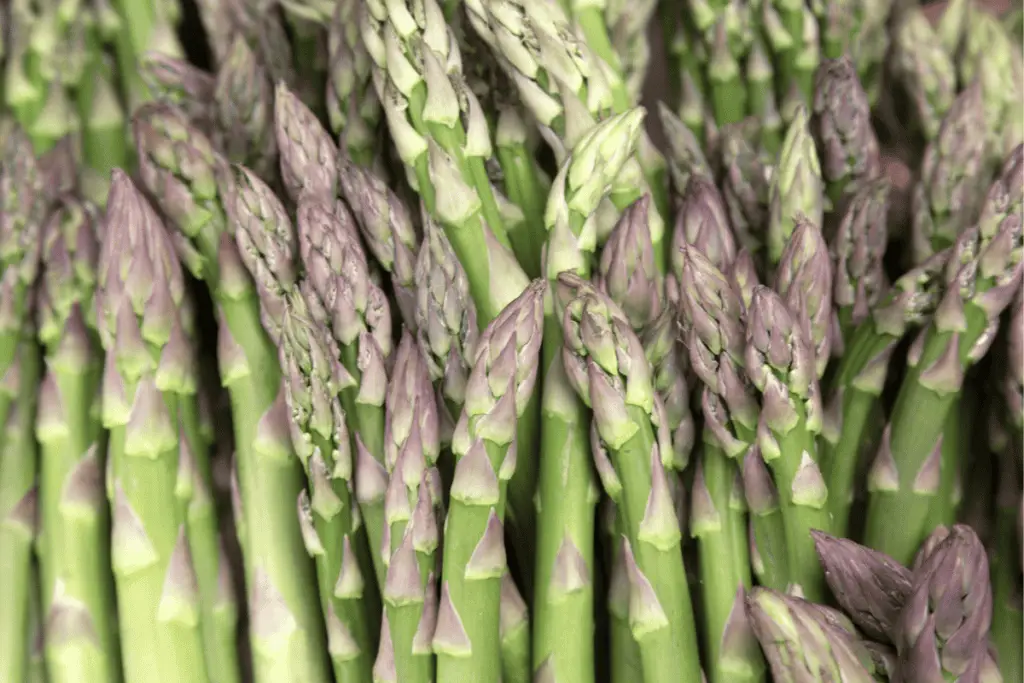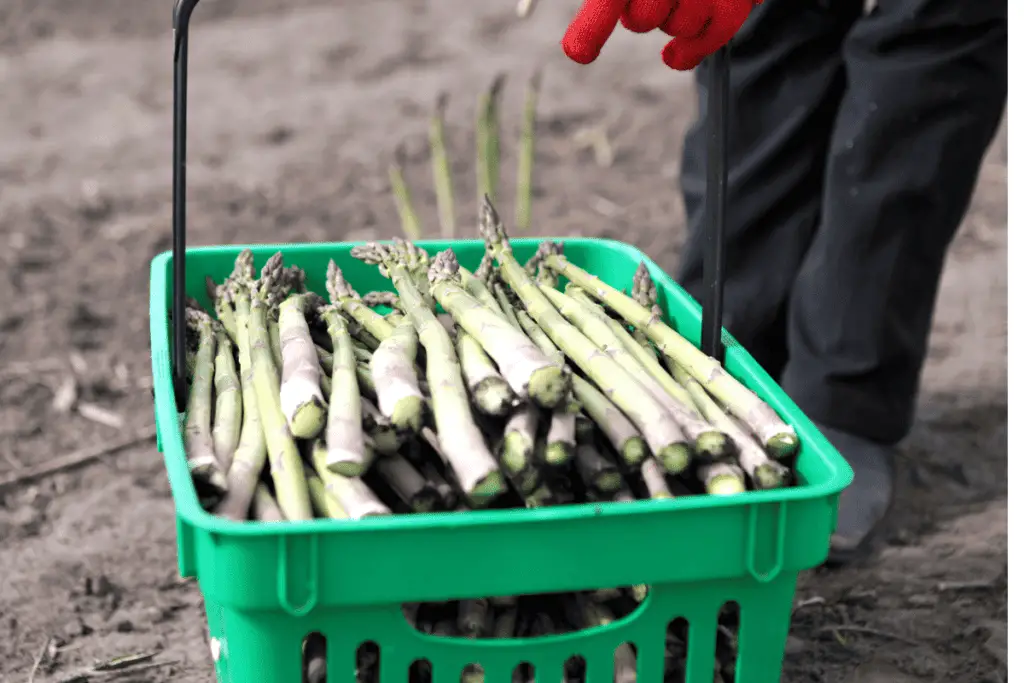If you’re limited on garden space but still dream of cultivating the fresh, crisp taste of asparagus, you’re in luck! Growing asparagus in a container is a practical and rewarding solution that allows you to enjoy this delightful vegetable without a sprawling garden. Let’s dive into a comprehensive guide on how growing asparagus in a container.

I. Selecting the Right Container
- Container Size:
- Choose a large, deep container to accommodate the extensive root system of asparagus. A container with a minimum depth of 18 inches is ideal.
- Material:
- Opt for a container made of durable materials such as plastic, wood, or ceramic.
- Drainage Holes:
- Ensure the container has proper drainage holes to prevent waterlogging.
II. Choosing the Asparagus Variety

Select a compact and container-friendly variety of asparagus, such as ‘Mary Washington’ or ‘Purple Passion.’ These varieties adapt well to the confined space of a container.
III. Potting Mix and Planting Asparagus Crowns
- Potting Mix:
- Use a well-draining potting mix enriched with organic matter.
- Planting Asparagus Crowns:
- Place the asparagus crowns in the container, ensuring they are covered with about 2 inches of soil.
- Spacing:
- Follow proper spacing guidelines, leaving enough room between crowns to allow for optimal growth.
IV. Positioning the Container
- Sunlight:
- Choose a sunny location for your container, providing at least 8 hours of sunlight per day.
- Temperature:
- Asparagus thrives in moderate temperatures, so keep the container in an area with consistent temperatures between 65-75°F.
V. Watering and Feeding
- Watering:
- Keep the soil consistently moist but not waterlogged. Ensure proper drainage to prevent root rot.
- Fertilizing:
- Apply a balanced fertilizer during the growing season to support healthy asparagus growth.
VI. Providing Support
As asparagus grows, provide support to prevent bending. Consider using stakes or a trellis to help the spears grow upright.
VII. Thinning and Harvesting

- Thinning:
- Thin out weaker shoots to allow stronger ones to flourish.
- Harvesting:
- Wait until the second year to start harvesting, allowing the plant to establish a robust root system. Harvest when the spears reach 6-8 inches, cutting just above the soil.
VIII. Dealing with Common Issues
- Pests:
- Keep an eye out for pests like aphids or spider mites. Use natural remedies or insecticidal soap if necessary.
- Diseases:
- Ensure good air circulation to prevent fungal diseases.
IX. Enjoying Container-Grown Asparagus

- Culinary Delights:
- Explore various recipes and savor the unique taste of your homegrown asparagus.
- Container Maintenance:
- Regularly check for any signs of pests, diseases, or nutrient deficiencies. Address issues promptly for a healthy crop.
X. FAQs About Growing Asparagus in a Container
1. Can I grow different vegetables with asparagus in the same container?
Yes, it’s possible to grow different vegetables with asparagus in the same container, but it’s essential to consider the specific needs of each plant. Asparagus prefers well-drained soil and may not thrive if overshadowed or crowded by other plants. Choose companion vegetables with similar water and sunlight requirements to ensure a harmonious growing environment.
2. How often should I water container-grown asparagus?
The frequency of watering for container-grown asparagus depends on various factors such as climate, container size, and soil conditions. Generally, it’s recommended to keep the soil consistently moist but not waterlogged. Check the top inch of soil regularly, and when it feels slightly dry, water thoroughly. Adjust the watering schedule based on environmental conditions to prevent both underwatering and overwatering.
3. Can I keep the container indoors during winter?
While asparagus is typically grown outdoors, container-grown plants can be brought indoors during winter in regions with harsh weather conditions. Place the container in a cool, dark location with good air circulation. Reduce watering during this dormant period. Ensure the asparagus receives some cold exposure, as it helps in the dormancy process. Return the container outdoors when the risk of frost has passed in the spring.
4. What is the best time to plant asparagus in a container?
The best time to plant asparagus in a container is in early spring, as soon as the soil is workable and the threat of frost has passed. Asparagus plants prefer cool temperatures for establishment. Planting in spring allows the roots to establish before the onset of summer heat. Choose a container with good drainage, and use a high-quality potting mix to provide the necessary nutrients for healthy growth.
. Can I reuse the potting mix for multiple growing seasons?
Yes, you can reuse the potting mix for multiple growing seasons with proper care. Before each new planting season, remove the top layer of the old potting mix and replace it with fresh mix. Additionally, amend the existing mix with compost or well-rotted manure to replenish nutrients. Reusing potting mix can be cost-effective, but maintaining soil fertility is crucial for the continued success of your container-grown asparagus and other plants
Conclusion Growing Asparagus in a Container
Growing asparagus in a container is a space-saving delight that opens up possibilities for those with limited garden space. With careful attention to container size, variety selection, and proper care, you can enjoy the crisp taste of asparagus right from your patio or balcony.
Latest Posts
- What Types of Lettuces Can You Grow?

- How to Plant Onion Seeds for Maximum Germination

- How to Plant Parsnip Seeds for Maximum Germination

- How to Plant Mushroom Seeds for Maximum Germination

- How to Plant Lettuce Seeds for Maximum Germination

- How to Plant Kale Seeds: A Step-by-Step Guide to Maximum Germination Success!

Additional Information Growing Asparagus in a Container
https://www.almanac.com/plant/asparagus




